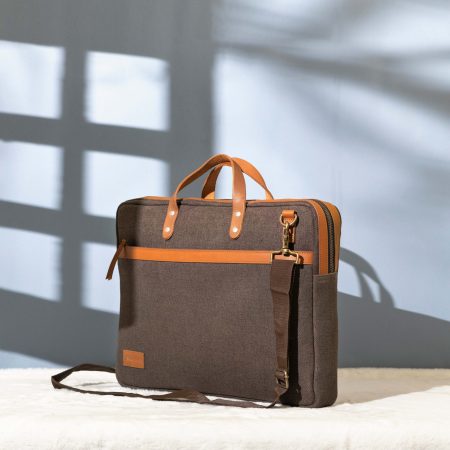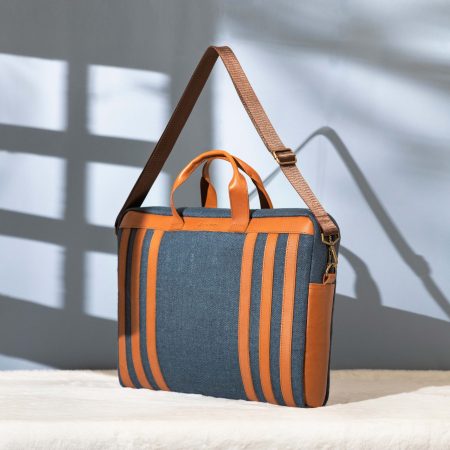Karatoya
৳ 800.00
ফোন, চাবি,নোটবুক, ফেসমাস্কসহ ব্যবহার্য টুকিটাকি সব কিছুই রাখার জন্য ভেতরে-বাইরে বেশ কিছু পকেট ও অনেক জায়গাসহ ব্যাগটি একদম পারফেক্ট। ৮-১০ ইঞ্চি সাইজের ট্যাবলেটও জায়গা করে নেবে অনায়াসে। হালকা ওজনের মেসেঞ্জার ব্যাগটি দেখতে ভীষণ ক্লাসিক এবং স্টাইলিশ।
– সাইজ: ১০”×৭”×২.৫”।
– মেটেরিয়াল: জুট ফেব্রিক এবং লেদার।
– দুটি রঙে পাওয়া যাচ্ছে।
- Delivery & Return
Delivery
আমরা পুরো বাংলাদেশে হোম ডেলিভারি দিয়ে থাকি। ডেলিভারির সময় ২-৫ দিন। পণ্যের আকার, ওজন এবং আপনার লোকেশনের উপর নির্ভর করে ৮০-১৫০ টাকা ডেলিভারি চার্জ প্রযোজ্য।Return
আমরা প্রতিটি পণ্য খুবই যত্নের সাথে কোয়ালিটি কন্ট্রোল করি। পণ্যটি নেওয়ার সময় অবশ্যই ভালোভাবে চেক করে নেওয়ার অনুরোধ রইল। এর পরও যদি কোন সমস্যা হয় তাহলে ডেলিভারির ৭ দিনের মধ্যে রিফান্ডের (শর্ত সাপেক্ষে) ব্যবস্থা আছে।Help
যেকোন প্রয়োজনে আমাদের সাথে যোগাযোগ করুন। Facebook: https://www.facebook.com/kalindi.com.bd Phone: +880 1810151890 Email: [email protected]
করতোয়া
করতোয়া নদী ভুটান সীমান্তের উত্তরে হিমালয় পর্বতমালা থেকে উৎপন্ন হয়ে পশ্চিমবঙ্গের দার্জিলিং ও জলপাইগুড়ির মধ্য দিয়ে বাংলাদেশে প্রবেশ করেছে। এখানে বৃহত্তর রংপুর-বগুড়া-পাবনা জেলার মধ্য দিয়ে রংপুরের প্রায় ১৯ কিমি দক্ষিণ-পশ্চিমে কতিপয় জলধারার সংযোগে সৃষ্ট নতুন উৎসমুখ থেকে আনুমানিক ২৪২ কিমি দক্ষিণে ইছামতি নদীর সঙ্গে মিলিত হয়েছে। উত্তরতম প্রবাহে এর নাম তিস্তা। অতীতে তিস্তার এই জলধারা তিনটি খাতে প্রবাহিত হতো— করতোয়া, আত্রাই, পুনর্ভবা। গতিপথের বিভিন্ন অংশে করতোয়া এখনো পুরাতন তিস্তা নামে অভিহিত হয়ে থাকে। অতীতে করতোয়ার মাধ্যমেই তিস্তার জলরাশি গঙ্গায় গিয়ে পড়ত। ১৭৮৭ সালের ২৭ আগস্ট এক বিশাল বন্যার ফলে করতোয়ার সঙ্গে তিস্তার সংযোগ বিচ্ছিন্ন হয়ে যায়। বর্তমান করতোয়া কিছুটা দিনাজপুর ও রংপুর জেলার সীমানা নির্ধারণ করে প্রবাহিত হওয়ার সময় পূর্ব দিক থেকে আসা দুটি উপনদী সর্বমঙ্গলা ও যমুনেশ্বরীকে গ্রহণ করেছে। চীনের বিখ্যাত পরিব্রাজক হিউয়েন সাঙ করতোয়া নদী পেরিয়ে ‘প্রাগজ্যোতিষপুর’ গিয়েছিলেন বলে কথিত আছে। প্রাচীন করতোয়া তখন সাদনীরা নামে খ্যাত ছিল।
আড়াই হাজার বছর আগে প্রাচীন বাংলার রাজধানী বগুড়ার ঐতিহাসিক মহাস্থানগড় এই নদী তীরেই অবস্থিত। করতোয়া নদীর নামকরণ নিয়ে একটি পৌরাণিক কিংবদন্তি আছে। কর অর্থ হাত, আর তোয়া অর্থ জল। হিন্দু দেবতা শিব হিমালয় পর্বতকন্যা পার্বতীকে বিয়ে করেন। বিয়ের অনুষ্ঠানে শিবের হাতে (কর) যে জল (তোয়া) ঢালা হয় সেই পানি নিঃসৃত হয়ে করতোয়া নদীর সৃষ্টি। ১৯১০ সালে প্রকাশিত বগুড়া জেলার গেজেটিয়ারে জে এন দাশগুপ্ত এই কিংবদন্তির উল্লেখ করেছেন। মহাভারতের বনপর্বের তীর্থযাত্রা অধ্যায়ে করতোয়া পুণ্যতোয়া নামে অভিহিত। পুণ্য অর্থ পবিত্র, তোয়া অর্থ জল। এই নদীর পবিত্রতা সম্বন্ধে দ্বাদশ শতাব্দীর কবি পণ্ডিত পরশুরাম সংস্কৃত ভাষায় ‘করতোয়া মাহাত্ম্য’ নামে একটি কাব্যগ্রন্থ রচনা করেন।
১২০৪ খ্রিষ্টাব্দে তুর্কি সেনাপতি ইখতিয়ার উদ্দিন মুহাম্মাদ বিন বখতিয়ার খিলজি বাংলা অভিযানকালে করতোয়া গঙ্গা নদীর চেয়ে তিন গুণ বড় ছিল। তিস্তার ক্ষয়ে যাওয়া পুরানো গতিপ্রবাহই আজকের করতোয়া। অষ্টাদশ শতাব্দীর দ্বিতীয় ভাগে কবি রতিরাম ছিলেন রংপুরের পীরগাছা থানার ইটাকুমারীর অধিবাসী। রতিরাম দাসের ‘রঙ্গপুরের জাগের গান’-এ করতোয়া নদীর প্রসঙ্গ এসেছে। এ নদীর পার্শ্ববর্তী নওগাঁ, অষ্টমনিষা, মির্জাপুর, মাটিয়াদহ ইত্যাদি স্থানে হিন্দুদের গঙ্গাস্নান বা বারুণী স্নান হয়ে থাকে।
করতোয়া বগুড়া জেলার শিবগঞ্জ থেকে পাবনা জেলার বাঘাবাড়ী পর্যন্ত এসে হুরাসাগর নদীতে পড়েছে। বগুড়া জেলার করতোয়া তীরে গুজিয়া, শিবগঞ্জ, আঁচলাই, রায়নগর, মহাস্থান, গোকুল, মাটিডালি, বগুড়া শহর, মাদলা, চাচাইতারা, আড়িয়া, শেরপুর প্রভৃতি বন্দর-শহর গড়ে উঠেছে। করতোয়া তীরবর্তী ঘোড়াঘাট একসময় প্রসিদ্ধ স্থান ছিল। কিংবদন্তি আছে, এই স্থানে মহাভারতে উল্লেখিত বিরাট রাজার ঘোড়ার আস্তাবল ছিল বলে এই স্থানের নাম ঘোড়াঘাট হয়। ঘোড়াঘাটের প্রাচীন কীর্তির অনেকটাই আজ নদীগর্ভে বিলীন। ঘোড়াঘাট ইউনিয়নের সাহেবগঞ্জ মৌজায় ঘোড়াঘাট দুর্গ। দুর্গের পূর্ব দিকে প্রবাহিত করতোয়া নদী এবং পশ্চিম, দক্ষিণ ও উত্তর দিক পরিখাবেষ্টিত। সুলতানী আমলের আগে এ দুর্গের ভিত প্রতিষ্ঠিত হলেও মোগল আমলে এসে এর চরম উন্নতি সাধিত হয়। ১৭৫৬ সালে ইংরেজ সেনাপতি কট্রিল ঘোড়াঘাটে শেষ মুসলমান ফৌজদার মীর করম আলী খানকে পরাজিত ও বিতাড়িত করেন। ঘোড়াঘাটের পতন হলে ডোমার একটি বাণিজ্যকেন্দ্র হিসেবে প্রতিষ্ঠা লাভ করে। অতীতকাল থেকেই করতোয়া অববাহিকার মানুষের জীবন ও জীবিকা অনেকাংশেই করতোয়া নদী কেন্দ্রিক। করতোয়া এবং এর উপ ও শাখানদ-নদী বিধৌত এ পললভূমির জনগণের জীবিকা কৃষি নির্ভর হলেও অন্যান্য পেশাজীবীর মানুষও বসবাস করে। একসময়ে নদী কেন্দ্রিক নৌ-যোগাযোগ প্রধান যাতায়তের মাধ্যম হওয়ার জন্য এ পেশাতে অনেকে সম্পৃক্ত থাকলেও বর্তমানে তা অনেকাংশেই কমে গেছে। আবার করতোয়া নদী এবং এর দহ বা মনি, খাল-বিলসহ পরিত্যক্ত পথসমূহের বিভিন্ন প্রজাতির দেশি মাছের ওপর নির্ভর করে সুপ্রাচীনকাল থেকে যে মৎস্যজীবী সম্প্রদায় নদীর তীরবর্তী অঞ্চলে গড়ে উঠে। বর্তমানে নদীতে মাছের পরিমাণ ক্রমান্বয়ে হ্রাস পাওয়ার কারণে তাদের বড় অংশের পেশা পরিবর্তন হয়েছে। এছাড়া করতোয়ার ভাটি অঞ্চলে পাবনা ও সিরাজগঞ্জ জেলাতে গোচারণভূমি বা বাথান কেন্দ্রিক উন্নতজাতের গাভী পালনের মাধ্যমে স্থানীয় পর্যায়ে কর্মসংস্থানের সৃষ্টি হয়েছে।
Karatoya
The Karatoya River originates from the Himalayas, north of the Bhutan border, and flows through Darjeeling and Jalpaiguri in West Bengal before entering Bangladesh. In Bangladesh, it traverses the greater Rangpur, Bogura, and Pabna districts. About 19 kilometers southwest of Rangpur, it merges with other streams to form a new mouth, flowing approximately 242 kilometers south to join the Ichamati River. The uppermost stream is known as the Teesta. Historically, the Teesta flowed through three channels: the Karatoya, Atrai, and Punarbhaba. In certain sections, the Karatoya is still referred to as the Old Teesta. Previously, the waters of the Teesta flowed into the Ganges via the Karatoya. However, a massive flood on August 27, 1787, severed the connection between the Teesta and the Karatoya. The present Karatoya partially defines the boundary between Dinajpur and Rangpur districts and receives two tributaries, the Sormongola and the Jamuneswari, from the east. It is said that the famous Chinese traveler Xuanzang crossed the Karatoya to reach Pragjyotishpur. In ancient times, the Karatoya was known as Sadinira.
About 2,500 years ago, the ancient capital of Bengal, Mahasthangarh in Bogura, was situated on the banks of the Karatoya River. A myth regarding the naming of the Karatoya suggests that “kar” means hand and “toya” means water. According to legend, Hindu god Shiva married Parvati, the daughter of the Himalayas. During the wedding, water poured over Shiva’s hands (kar) and flowed to create the Karatoya River. This legend is mentioned in the 1910 Bogura district gazetteer by J.N. Dasgupta. In the pilgrimage chapter of the Mahabharata, the Karatoya is called Punnyatoya, with “punya” meaning sacred and “toya” meaning water. The poet Pandit Parashuram wrote a Sanskrit poem titled “Karatoya Mahatmya ” in the twelfth century, extolling the river’s sanctity.
In 1204 AD, the Turkish general Ikhtiyar Uddin Muhammad bin Bakhtiyar Khilji encountered the Karatoya, which was then three times larger than the Ganges. The present Karatoya is a remnant of the old Teesta’s eroded course. In the late eighteenth century, poet Ratiram lived in Itakumari, Pirgachha Thana, Rangpur, and mentioned the Karatoya in his song “Rangpur’s Jager Gaan.” The river is also associated with Hindu rituals such as the Ganga Snan or Baruni Snan at places like Naogaon, Ashtamanisha, Mirzapur, Matiadah, etc.
The Karatoya flows from Shibganj in Bogura district to Baghabari in Pabna district, where it merges with the Hurasagar River. Several ports and towns, including Gajia, Shibganj, Anchali, Raynagar, Mahasthangarh, Gokul, Matidali, Bogura town, Madla, Chachaithara, Aria, and Sherpur, have developed along the Karatoya in Bogura district. Ghoraghat, once a famous place near the river, is said to have been the stable of King Virata’s horses as mentioned in the Mahabharata, giving it the name Ghoraghat. Many ancient structures in Ghoraghat have been eroded by the river. Ghoraghat Fort, located in Sahebganj Mouza of Ghoraghat Union, is bordered by the Karatoya River to the east and is surrounded by ditches on the west, south, and north. Though the fort’s foundation predates the Sultanate period, it flourished during the Mughal era. In 1756, British commander Cottrell defeated and ousted the last Muslim faujdar of Ghoraghat, Mir Karam Ali Khan. The fall of Ghoraghat led to the rise of Domar as a trading center. The livelihood of people in the Karatoya basin has long been centered around the river. While agriculture remains the primary occupation, other professions have developed. Once a major route for water-based transport, the significance of river navigation has diminished over time. The fishing communities, reliant on the Karatoya and its tributaries, have seen a decline in fish stocks, leading many to change their professions. In the lower reaches of the Karatoya, grazing lands in Pabna and Sirajganj districts have created local employment through dairy farming with improved cattle breeds.
The Karatoya River remains an integral part of the region’s historical, cultural, and economic landscape, shaping the lives and livelihoods of the people who live along its banks.
Related Products
কালিন্দীর জনপ্রিয় প্রডাক্টগুলোর মধ্যে পাটের ওয়ালেট গুলো অন্যতম। জুট এবং লেদার কম্বিনেশনে ভীষণ স্টাইলিশ এই ওয়ালেট দুটি ভিন্ন ভিন্ন রঙে পাওয়া যাচ্ছে।
সাইজঃ ৪” × ৪.৫”।
Out of stock
কালিন্দীর নতুন সংযোজন ধানসিঁড়ি। আকারে বড় এবং ডুয়েল কম্পার্টমেন্ট থাকায় জিনিসপত্র রাখার জন্য জায়গাও থাকছে অনেক বেশি। হালকা ওজনের শক্তিশালী এই ব্যাগটিকে বহনের জন্য রয়েছে টেকসই চামড়ার হাতল, এবং কাঁধে ঝুলানোর জন্য ডিটাচেবল স্ট্রাপ।
অফিস অথবা ভ্রমণের সঙ্গী হিসেবে অনেকেই একটু বেশি স্পেসের ব্যাগ খুঁজে থাকেন, তাদের জন্য এটি একটি নিখুঁত সঙ্গী হতে পারে।
– সাইজঃ ৯.৫” × ১২.৫” × ৪”।
– মেটেরিয়ালঃ ১০০% পাট এবং লেদার।
Out of stock
ক্যাম্পাস, অফিস কিংবা বিজনেস ট্রিপ- উপলক্ষ্য যেটাই হোক, স্টাইলিশ এই ব্যাগটি আপনার প্রিয় ল্যাপটপকে রাখবে সুরক্ষিত।
– সাইজ: ১২” × ১৫” × ৩.৫”
– ম্যাটেরিয়াল: পাট এবং ভেজিটেবল ট্যানড লেদার।
– দুটি রঙে পাওয়া যাচ্ছে।
Out of stock
এতে ১২ থেকে ১৬ ইঞ্চি সাইজের ল্যাপটপ বহন করতে পারবেন অনায়াসে।
অফিস, ক্যাম্পাস, অথবা ব্যবসায়িক ভ্রমণে আপনার প্রিয় ল্যাপটপটিকে সুরক্ষিত রাখতে এবং সহজে বহন উপযোগী করে তুলতে কালিন্দী তৈরি করেছে বেস্ট কোয়ালিটির ল্যাপটপ ব্যাগ। পাটের তৈরি এই ল্যাপটপ ব্যাগটি হতে পারে আপনার প্রিয় ল্যাপটপের প্রয়োজনীয় সঙ্গী।
– সাইজ: ১২” × ১৬” ×২.৫”
– ম্যাটেরিয়ালঃ পাট এবং ভেজিটেবল ট্যানড লেদার।
Out of stock
This vintage design laptop bag is called “Karnaphuli”.
Office, campus, or business trip to keep your favorite laptop safe Kalindi designed this laptop bag. Made out of premium quality jute fabric, this laptop bag can be an essential companion to your favorite laptop.
– Measurements: 12″ × 16″ × 3″
– Available in two different colors.
– Material: High-quality jute fabric and vegetable tanned leather.
ভিন্টেজ ডিজাইনের এই ল্যাপটপ ব্যাগটির নাম “কর্ণফুলী”।
অফিস, ক্যাম্পাস, অথবা ব্যবসায়িক ভ্রমণে আপনার প্রিয় ল্যাপটপটিকে সুরক্ষিত রাখতে এবং সহজে বহন উপযোগী করে তুলতে কালিন্দী তৈরি করেছে বেস্ট কোয়ালিটির ল্যাপটপ ব্যাগ। পাটের তৈরি এই ল্যাপটপ ব্যাগটি হতে পারে আপনার প্রিয় ল্যাপটপের প্রয়োজনীয় সঙ্গী।
– সাইজঃ ১২” × ১৬” × ৩”।
– মেটেরিয়ালঃ পাটের ফেব্রিক এবং ভেজিটেবল ট্যানড লেদার।
Out of stock
ভ্রমণ অথবা রেগুলার ব্যবহারের জন্য ব্যাকপ্যাক আরামদায়ক ক্যারি ব্যাগ হিসেবে সুপরিচিত।এর একটি উল্লেখযোগ্য কারন এই ব্যাগগুলোতে ডাবল হ্যান্ডেল থাকে,এবং তা কাঁধে বহন করা যায়।কাঁধে বহন করায় ব্যাগের মূল ভার পিঠের উপর ছড়িয়ে যায়,যার ফলে ব্যাগ ক্যারি করতে কষ্ট কম হয়।
নতুন বছরে কালিন্দীতে যোগ হলো “কংস” নামের এই ব্যাকপ্যাকটি।
– সাইজ: ১৪” × ১১” × ৫”
– ম্যাটেরিয়াল: জুট এবং লেদার।
কালিন্দীর জনপ্রিয় প্রডাক্টগুলোর মধ্যে পাটের ওয়ালেট গুলো অন্যতম। জুট এবং লেদার কম্বিনেশনে ভীষণ স্টাইলিশ এই ওয়ালেট দুটি ভিন্ন ভিন্ন রঙে পাওয়া যাচ্ছে।
– সাইজঃ ৪” × ৭.৫”





















